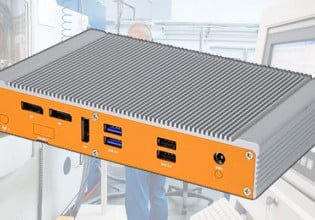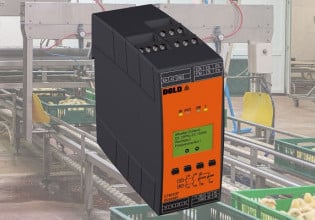Introduction to Single Pair Ethernet (SPE)
Industrial Ethernet is getting a facelift, but will the industry adopt this new change? Single Pair Ethernet (SPE) offers gigabit speeds with a reduced footprint. When is it used, and where?
Industrial network topology has seen many transitions over the years. It all started with serial communication using a single pair of wires transmitting string commands to one device. Later, serial communication was expanded to allow multiple devices on the same network and commands could be addressed to individual devices.
In the ’90s there were proprietary communications that were based on serial infrastructure. Once Ethernet came onto the scene in computers and office equipment, the industrial world took notice and eventually adopted the technology. Today, most medium to large-sized automation equipment utilizes an industrial Ethernet network for communication between devices or other automation controllers.

Figure 1. A standard Ethernet cable with four twisted wire pairs next to a SPE connection with one pair of wires. Image used courtesy of Lapp Group
What is Single Pair Ethernet (SPE)?
Backing up a step to the previous generation, a standard Ethernet cable consists of four twisted pairs of wires—eight wires total—that provide gigabit speeds. These wires carry the transmit (Tx) and receive (Rx) signals for all the devices on the network.
A SPE connection uses one pair of wires—two wires total—that also provide gigabit speeds. The reduction of wires within the cable greatly reduces the overall weight and size of the cable. The connectors can also be reduced in size as they will no longer have to support eight conductors.
The SPE topology can also support Power over Data Line (PoDL), which is used to supply power for enabled devices and communication all over the same two wires.

Figure 2. Ethernet is used in typical machine networks for communication between devices or controllers. Image used courtesy of Jordan Harrison
Ethernet Topology and Communication
A typical machine network might use Ethernet for communications between data systems and a PLC or a branching device that communicates to many field devices on another bus. It is not common for field devices, such as sensors, to have a direct connection to Ethernet. The connections are large and require expensive hardware.
Common Fieldbus technology similar to RS485 or CAN bus has been used for many years to communicate with devices in the field. A common example is a vehicle. There are many sensors within a vehicle that need to communicate with a central control system. These sensors use CAN bus as their communication protocol.
Recently, the technology seen in vehicles is advancing to the point where CAN bus can no longer support the devices being installed in vehicles. Camera systems, backup systems, and autonomous driving systems require fast data transmissions. The factory floor is seeing a similar trend with IIoT requiring real-time data acquisition to cloud services.

Figure 3. Standard Ethernet vs SPE. Image used courtesy of SPE Industrial Partner Network
Field Level Communication
For a sensor to be able to communicate with any cloud IIoT service, it almost certainly needs to have an Ethernet connection. Most sensors, however, are small and unable to support both initial functions plus add Ethernet as an additional layer. With SPE, a device only requires an additional two conductors or pins in the connector. With PoDL, the device can also be powered by Ethernet, which can greatly reduce the amount of wiring required.
Connecting sensors to Ethernet topology opens up many doors that previous bus technologies could not support. Time Sensitive Networking (TSN), for instance, is used extensively with safety-rated and real-time communications. By having sensors connected to this kind of network, door switches can be directly connected to a safety network or diagnostic data can be transmitted in real-time to cloud services.

Figure 4. SPE disadvantages include short cable distance and incompatible existing infrastructure. Image used courtesy of Belden
SPE Disadvantages
The biggest disadvantage to SPE is the max distance cables can travel before a repeater is required. With four-pair Ethernet transmission, speeds of 1 gigabit per second (Gbps) are maintainable up to a distance of 100 m. With SPE, that same speed maxes out at 40 m.
The other disadvantage is that infrastructure, offices, IT equipment, and computers already have standard setups that support the four-pair, RJ45 connectors. Changing this infrastructure to support SPE would be very costly without much gain.
A typical machine network is usually one subnet or one range of 0-255 IP addresses, and some PLCs have restrictions on how many connections there can be to the controller, typically around 30 connections. By adding more devices to the network, more money will need to be spent on expensive hardware to support these extra devices, and more complex networks will need to be designed.

Figure 5. SPE is believed to benefit vehicle networks and robotics. Image used courtesy of Nay
Automotive, Transportation, and Robotics
Where SPE really shines, however, is in locations where space saving is essential, such as automobiles and railway transit. Networks in vehicles are relatively short and would greatly benefit from a communication system that is significantly faster and capable of transmitting more data.
Robotics is another field that would benefit from SPE, being that robots require cables that are highly flexible. By using a cable with fewer conductors, the bend radius of the cable can be greatly decreased. This makes SPE a good choice for robots that work in tight locations.
While SPE does come at a cost with reduced maximum distances, it makes up for it with a compact size and expanded data transmission not seen with standard Fieldbus technology.







Correction: Cables with fewer conductors—> smaller overall diameter—> REDUCED minimum bend radius, not increased. Otherwise an interesting article on SPE.
There are sooo many issues with this that I just don’t know where to start?!!!
Why would any industrial installation want to replace 4 pairs of 100m cable with 1 pair that only runs 40m?? To save what? A few square mm?!
What about backwards compatibility? No 10 or 100 Mbps devices allowed on new networks because they can’t use the cabling?!
I have been in industrial automation for 25 years now, and I’ve seen less than 10 gigabit installations - and none of them are using the full bandwidth!!
What about the PLCs (and network switches and PCs/terminals for that matter) - are whoever came up with this idea expecting the entire industry to redesign and support a new connector, new firmware and probably new protocols for using less wires?!
Sorry, but I find this absolutely ridiculous :D